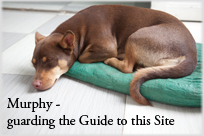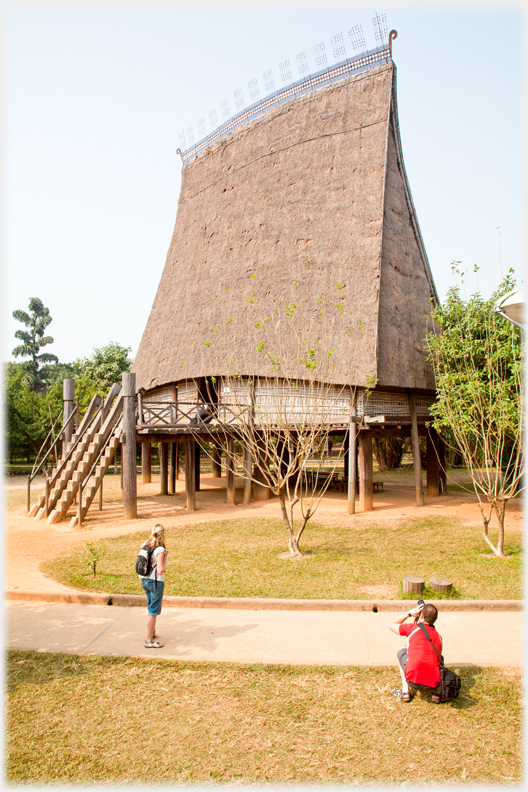 This is a Ba Na Communal House standing about 90 feet high (27 metres) found in Kon Tum Province, central Vietnam. It was built in the grounds of the museum with the help of the German government
Hà Nội, as befits Vietnam's capital, has the most splendid museum dedicated to the life and crafts of the nation's people. Smaller artefacts are housed inside the main building, while in the grounds a whole spectrum of Vietnamese vernacular housing has been reconstructed - often by people from the communities that live in these houses. Some examples from around Vietnam are found on other pages of this site and are linked to the pictures below. The museum was designed by Hà Đức Linh and opened in 1997; assistance was given by France to the venture. The
Vietnam Museum of Ethnology
This is a Ba Na Communal House standing about 90 feet high (27 metres) found in Kon Tum Province, central Vietnam. It was built in the grounds of the museum with the help of the German government
Hà Nội, as befits Vietnam's capital, has the most splendid museum dedicated to the life and crafts of the nation's people. Smaller artefacts are housed inside the main building, while in the grounds a whole spectrum of Vietnamese vernacular housing has been reconstructed - often by people from the communities that live in these houses. Some examples from around Vietnam are found on other pages of this site and are linked to the pictures below. The museum was designed by Hà Đức Linh and opened in 1997; assistance was given by France to the venture. The
Vietnam Museum of Ethnology
 offers a rich and detailed snapshot of Vietnam's ethnic variance, from tea cups to communal meeting houses - like the one to the left. This variety is summarised in the map of linguistic diversity just below. The exhibits are often simple and strikingly beautiful allowing the museum to act as a most excellent introduction to Vietnam.
offers a rich and detailed snapshot of Vietnam's ethnic variance, from tea cups to communal meeting houses - like the one to the left. This variety is summarised in the map of linguistic diversity just below. The exhibits are often simple and strikingly beautiful allowing the museum to act as a most excellent introduction to Vietnam.
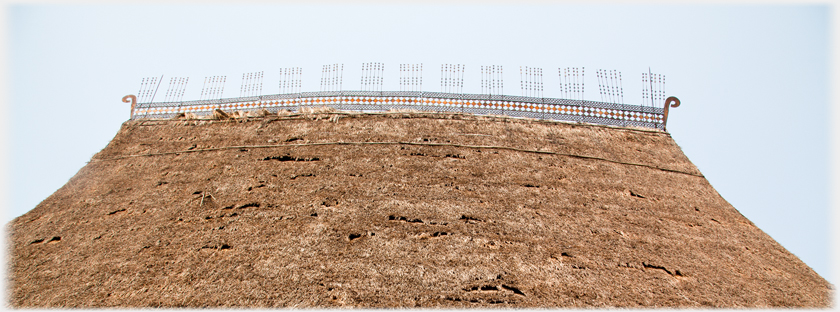 The decoration along the roof of the Ba Na house
The decoration along the roof of the Ba Na house
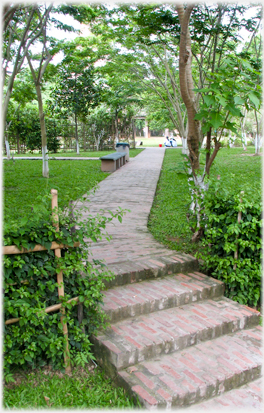 The pleasant grounds laid out between the reconstructed buildings, some of which are shown below
The pleasant grounds laid out between the reconstructed buildings, some of which are shown below
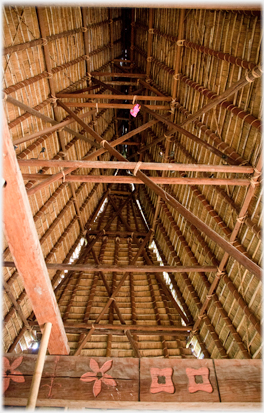 Looking up inside the roof of the Ba Na house - constructed by Kon Tum villagers
Looking up inside the roof of the Ba Na house - constructed by Kon Tum villagers
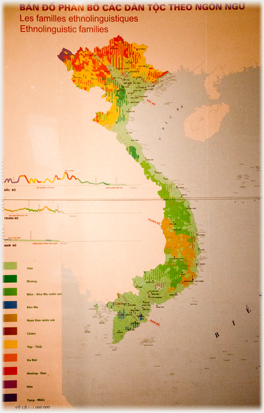 Map of the linguistic groupings found in Vietnam
Map of the linguistic groupings found in Vietnam
Click for an enlarged version
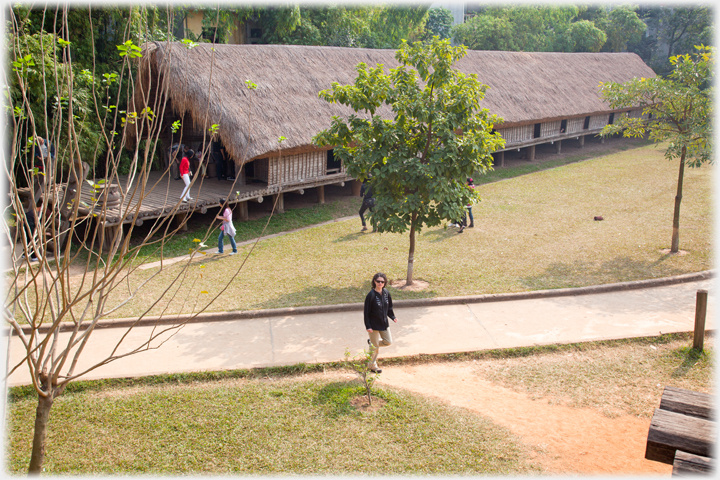 This beautiful example of a Long House - some 80 metres in length - comes from Buôn Ma Thuột in Đắc Lắc Province. The far end of this one, and other contemporary local examples, can be seen towards the bottom of the page on
Đà Lạt Country
This beautiful example of a Long House - some 80 metres in length - comes from Buôn Ma Thuột in Đắc Lắc Province. The far end of this one, and other contemporary local examples, can be seen towards the bottom of the page on
Đà Lạt Country

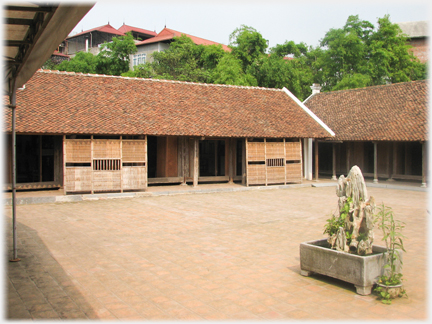 Courtyard of tiled houses
Courtyard of tiled houses
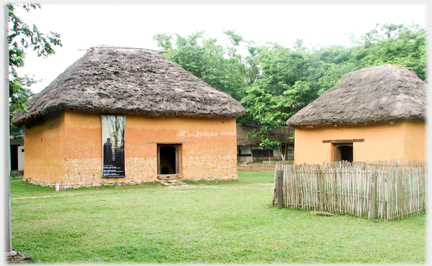 Above are examples of Hà Nhì adobe houses from the north-west of the country. These houses are built from the clay in the ground around them. The building of such a house can be seen on the page about
the road to Lũng Cú
Above are examples of Hà Nhì adobe houses from the north-west of the country. These houses are built from the clay in the ground around them. The building of such a house can be seen on the page about
the road to Lũng Cú

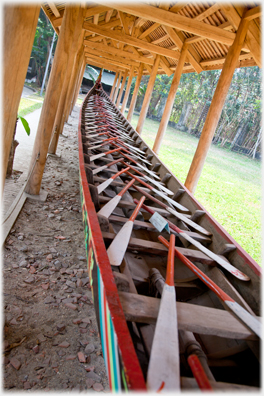 Forty-six seater racing canoe from Khmer people in Kiên Giang Province.
To an Indian version
Forty-six seater racing canoe from Khmer people in Kiên Giang Province.
To an Indian version

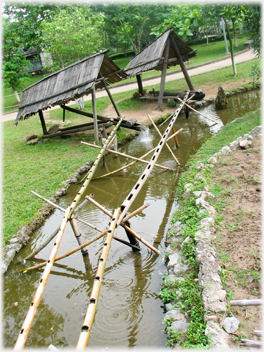 Bamboo water pipes conducting water to corn pounders. Water weighs down a beam; when up the water falls out; the hammer head drops and hits the corn in the bin
Bamboo water pipes conducting water to corn pounders. Water weighs down a beam; when up the water falls out; the hammer head drops and hits the corn in the bin
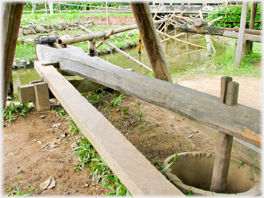 Pounder - hammer down
Pounder - hammer down
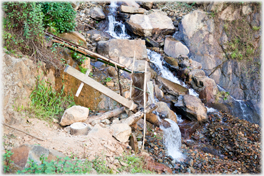 A working example in the north, hammer (towards the left) up
A working example in the north, hammer (towards the left) up
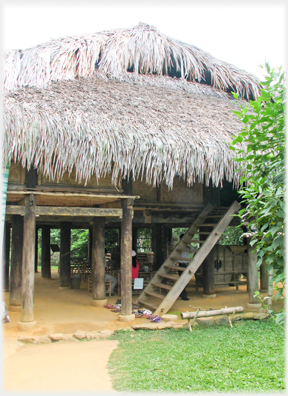 Thatched Thai style house. The framework of similar eves can be seen on the page on our
Cafe Roof
Thatched Thai style house. The framework of similar eves can be seen on the page on our
Cafe Roof

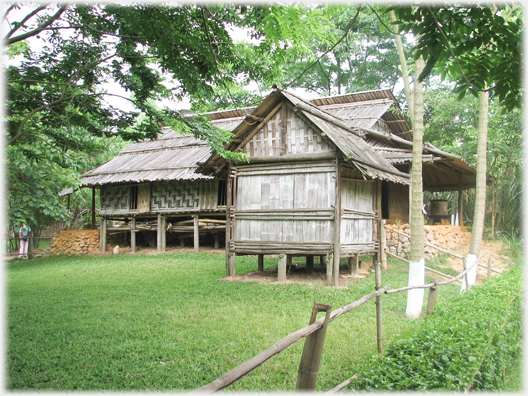 Another form of roofing and walls. The roof is constructed of bamboo poles split lengthwise and strapped down with cross bamboos. The walls are made of woven bamboo matting
Another form of roofing and walls. The roof is constructed of bamboo poles split lengthwise and strapped down with cross bamboos. The walls are made of woven bamboo matting
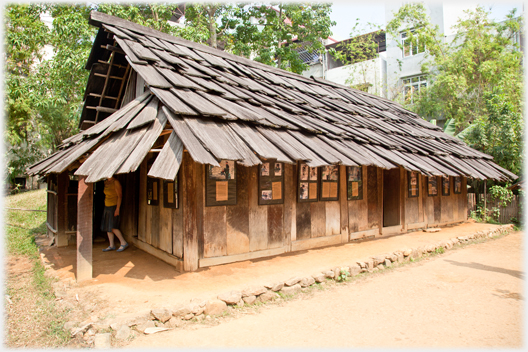 And another way of building houses. Thin sheets of wood forming shingles on the roof and walls
And another way of building houses. Thin sheets of wood forming shingles on the roof and walls
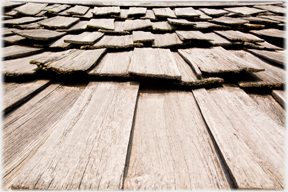 Although buckled the alternating pattern can be seen in these shingles - one on top, then one underneath
Although buckled the alternating pattern can be seen in these shingles - one on top, then one underneath
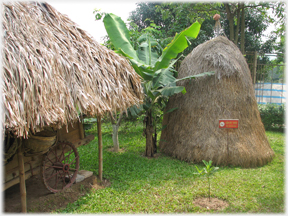 These Hay Stacks are common throughout the corn growing parts of the country. One in the wild one can be seen on
the next page
These Hay Stacks are common throughout the corn growing parts of the country. One in the wild one can be seen on
the next page

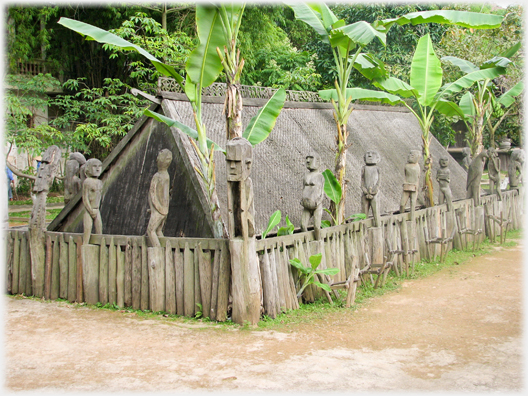 Unlike the other buildings on this page this one features regularly on the internet. It is a reconstructed Gia Rai Tomb House, an ethnic group of the central Highlands. Burials are communal in the mother's burial house - but the interest is less about the matrilineal system and more about the carvings that guard the house...
Unlike the other buildings on this page this one features regularly on the internet. It is a reconstructed Gia Rai Tomb House, an ethnic group of the central Highlands. Burials are communal in the mother's burial house - but the interest is less about the matrilineal system and more about the carvings that guard the house...
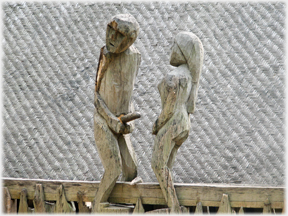 ...such as this man looking askance
...such as this man looking askance
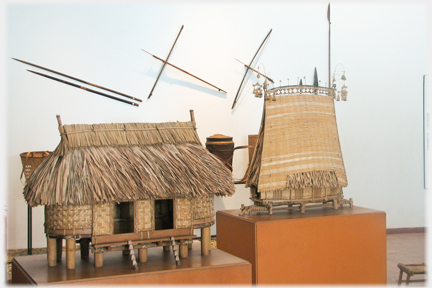 A model of the Kon Tum house inside the museum
A model of the Kon Tum house inside the museum
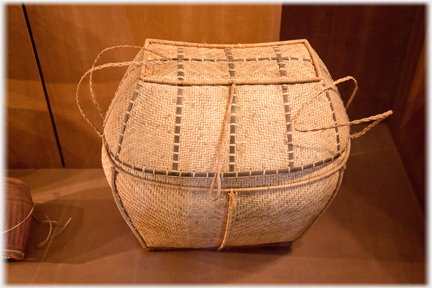 Basket work is a major Vietnamese craft
Basket work is a major Vietnamese craft
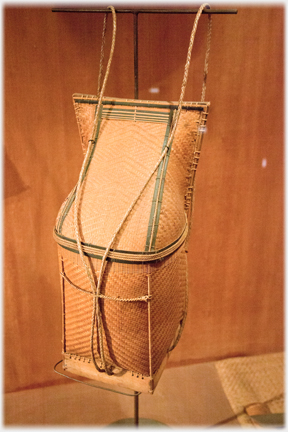 Another back-basket style. See below
the house building images
Another back-basket style. See below
the house building images
 for more
for more
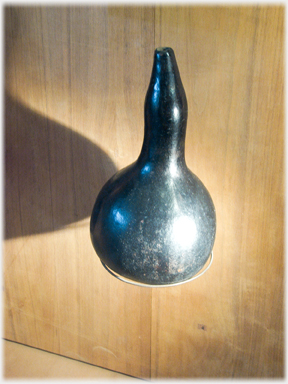 Inside the main museum building, well displayed objects from every corner of Vietnam are gathered. Above a water or alcohol container
Inside the main museum building, well displayed objects from every corner of Vietnam are gathered. Above a water or alcohol container
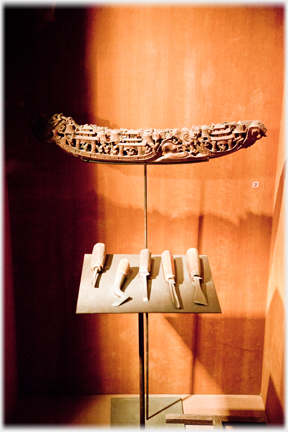 Dragon Boat carving and carver's tools from Huế dated 1923
Dragon Boat carving and carver's tools from Huế dated 1923
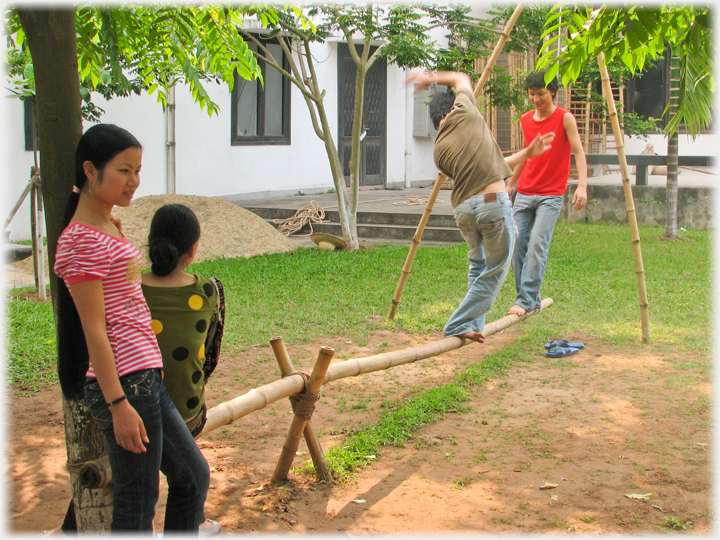 Interactive material in the grounds - visitors can try walking a pole suspended on a rope at one end. A similar challenge was posed in the canoe races on the
Lake in Đà Lạt
Interactive material in the grounds - visitors can try walking a pole suspended on a rope at one end. A similar challenge was posed in the canoe races on the
Lake in Đà Lạt

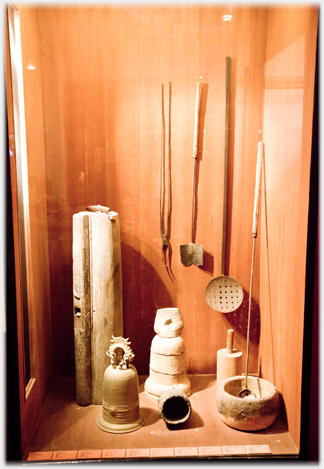 Bronze casting equipment - a craft dating back over two thousand years in Vietnam to a time when the Đông Sơn culture produced large bronze drums.
Bronze casting equipment - a craft dating back over two thousand years in Vietnam to a time when the Đông Sơn culture produced large bronze drums.
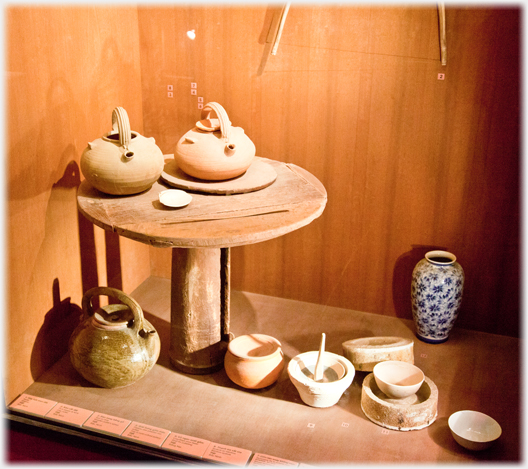 Pottery is a major craft throughout the country. A special interest to visitors are the pottery villages such as Bát Tràng just outside Hà Nội, where the whole community is devoted to the one trade providing a huge range of choice within a few yards walk
Pottery is a major craft throughout the country. A special interest to visitors are the pottery villages such as Bát Tràng just outside Hà Nội, where the whole community is devoted to the one trade providing a huge range of choice within a few yards walk
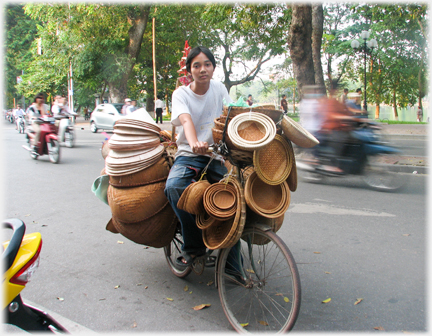 And back to basketry. This hawker was often seen around Hoàn Kiếm Lake with his laden cycle of baskets
And back to basketry. This hawker was often seen around Hoàn Kiếm Lake with his laden cycle of baskets
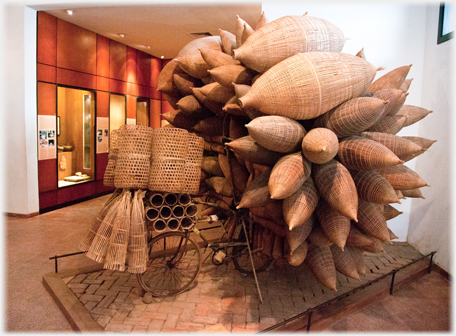 The museum features a famous image of a cycle - just visible under these woven creels
The museum features a famous image of a cycle - just visible under these woven creels
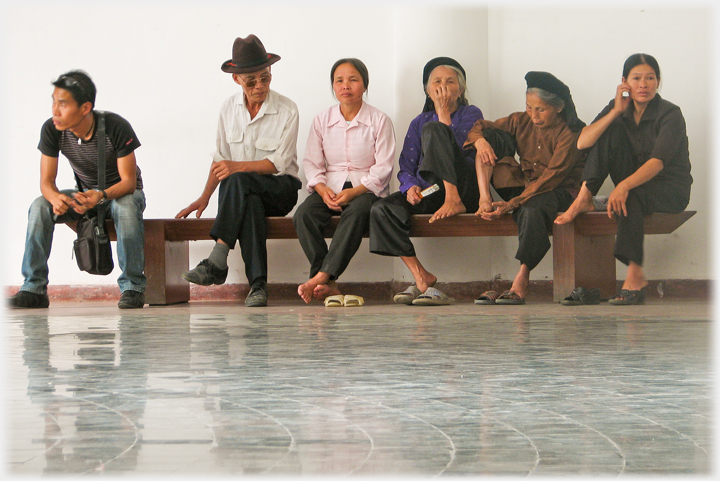 In the museum's foyer people wait. Kindly adding to this visitor's collection of ethnic experiences by demonstrating a variety of typical poses in one shot
Trailers...
In the museum's foyer people wait. Kindly adding to this visitor's collection of ethnic experiences by demonstrating a variety of typical poses in one shot
Trailers...
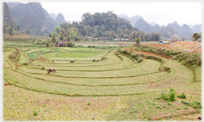 The next page returns
to northern Vietnam and more pictures from the delightful province of Cao Bằng.
The next page returns
to northern Vietnam and more pictures from the delightful province of Cao Bằng.
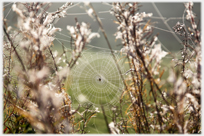 The next page
of the Mosaic Section is headed 'Vicissitudes'.
The next page
of the Mosaic Section is headed 'Vicissitudes'.
Or go to the contents of the Mosaic Section.

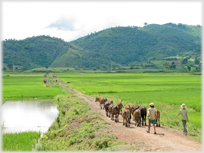 The last page was about the country around Đà Lạt
The last page was about the country around Đà Lạt
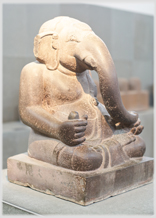
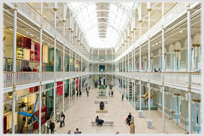 To the National Museum of Scotland
To the National Museum of Scotland
